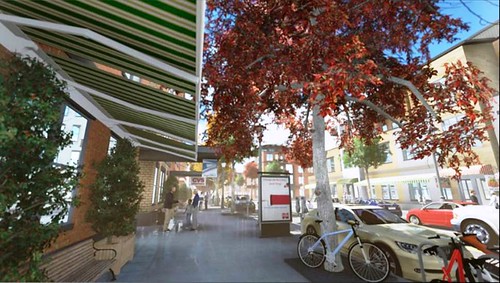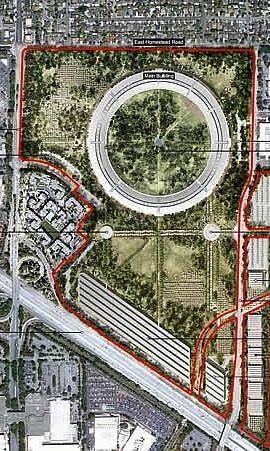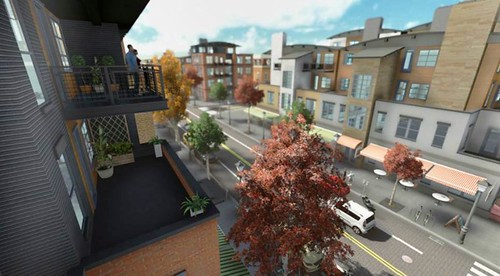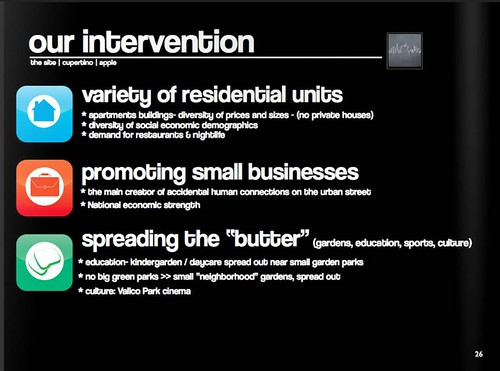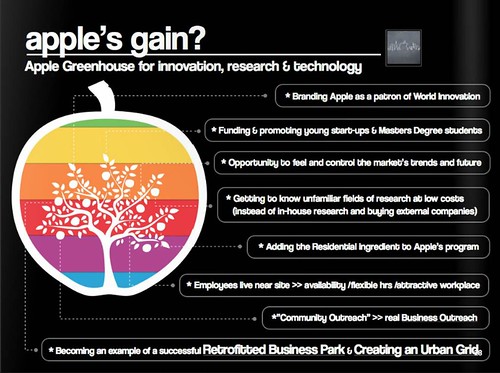The opportunity that Apple is missing to build a better neighborhood

Posted July 10, 2012 at 1:28PM
What Cupertino, California is getting
What Cupertino, California needs
I never intended to become so knowledgeable about Apple, Inc.’s new “spaceship” headquarters being developed in Cupertino, California. Really, I didn’t. But the design seemed to me to be way overscaled for humans and particularly wrong for a classic slice of California sprawl that is begging to be retrofitted into a more walkable and people-oriented environment. Apple is already a world leader in consumer technology; this was its chance to be a world leader also for community-oriented sustainability.
The corporation has already shown a commendable ability to support transit and walkability in certain neighborhoods where it has retail outlets. Another high-tech giant with a need for security, Amazon, is showing how to revive an older neighborhood for its new, highly walkable headquarters in Seattle. Google has signaled its strong desire to position its future headquarters amid a mixed-use, housing- and transit-rich environment. So the potential was there.
Instead, Apple chose to design its new headquarters as if it were a new consumer product, an “iBuilding” of sorts with a clean, high-concept design that reinforces the company’s futuristic corporate brand. In that sense, it probably succeeded: the building is cool-looking in an abstract sort of way, the kind of structure that will make people go “wow.” But it does nothing to make Silicon Valley a better environment for people, and might even make it harder to improve the walkability of Cupertino by sealing off potential walking routes.
So I called them on it, twice. And, man, did I get hammered by an army of Apple loyalists. “You’re just a hater and a loser” was one of the comments, and I think the writer probably spoke for 90 percent of the people who bothered to write. It didn’t help that one of the sites that publishes my work decided to run a headline that said “Why Apple’s new headquarters is bad for America.” That wasn’t quite what I said or believed, but I do believe the design is bad for Cupertino, and a poor representative of how suburban communities should be evolving in the twenty-first century.
I stand by that assessment, which was shared by other architecture and city thinkers. Instead of creating a look-at-me “statement” sort of building that stands alone, Apple should be increasing the connectivity of its site to the surrounding community. It should be building affordable housing integrated into its design. It should be transit-ready, facing the street, to make walking to and from buses and perhaps a future light rail line more logical and direct when more transit comes to Cupertino, as it surely will in some form. It should reduce the size of its ten thousand-vehicle parking garage.
Remarkably, two architecture students in Tel Aviv, Shay Levanon and Amir Levanon, have now issued a comprehensive report showing Apple exactly how to do just those things. Drawing from international examples of walkable places, and from sprawling suburban sites being retrofitted to become less car-oriented and more people-oriented, the students demonstrate how Apple could be making a powerful corporate design statement in favor of community and connectedness. Galena Tachieva, an expert in suburban architecture whom I believe was consulted on the project, puts it this way:
“Even without comparing this project to the very suburban and over- scaled proposal for Cupertino by [architects] Foster + Partners, one can easily observe the excellent qualities of this project. It is a rational and common-sense response to a real challenge -
how to incorporate an office campus of a world famous company within the context of a sprawling suburb. As I have argued before, the Foster plan missed an opportunity to correct past mistakes in the way the region grew, and to infuse sprawling Cupertino with a piece of real urbanism.
"Shay and Amir's project is doing exactly this: it creates simple and predictable urban fabric, but which is a decent, walkable human environment, instead of a spaceship isolated and disconnected from its surrounding . . . they came up with many creative ideas of how Apple can become a real positive force in the community of Cupertino, not only through excellent urbanism but also through innovative funding, branding and implementation”
That is extremely well put.
The students’ alternative plan, which was developed with the support of Professor Hillel Schocken, includes a multi-building concept for Apple’s own offices; a new, walkable street grid; human-scaled rental housing of various types; space for local businesses; neighborhood parks and gardens; places for retail; daycare and kindergarten facilities, not just for Apple employees but for the community; and nightlife and entertainment. Housing and mixed-use facilities would enable some employees to live and shop near work, as many Silicon Valley icons are advocating. The idea would be to create, in the students’ words, an “Apple Greenhouse for innovation, research and technology.”
Apple would be given the most prominent locations in the new neighborhood for its own buildings, which still could feature iconic design. (The renderings show rather ordinary California architecture, but they are just illustrative.) The difference for Cupertino would be that the community would have not just a new and prestigious corporate headquarters, but also a new neighborhood along with it.
All this is ambitious, to be sure. But Apple is exactly the kind of corporate giant with the clout and resources to pull it off.
If the shortcoming of Apple’s “spaceship” concept is that it neglects the community, a shortcoming of the students’ design is that it could have done much more for the environment. The students apply traditional urbanist design principles to the site, vastly improving it, but make no mention of such potential innovations as energy-saving district heating and cooling systems, green building materials and technology, use of native vegetation for landscaping, water efficiency, advanced waste management, or green infrastructure for streets, sidewalks, and rooftops. (Actually, these omissions are also a shortcoming of traditional urbanist design principles in general.) Maybe that’s a possibility for Professor Schocken’s next group of students?
Meanwhile, congratulations to the Levanons for a great piece of work that shows how a corporation with a suburban campus - but also with a strong will to have its design improve its community - might proceed.
Related posts:
- A high-tech corporate giant strengthens a walkable, transit-accessible neighborhood (March 14, 2012)
- How to retrofit failing suburban big-box stores into a green showcase (March 12, 2012)
- Official review finds environmental benefits from additional homes near Silicon Valley jobs (December 15, 2011)
- Why is Apple turning its back on the community? (June 21, 2011)
- Is it over for suburban corporate campuses? (May 31, 2011)
- Apple invests in public transit - with impressive, stylish results (November 2, 2010)
- Remaking a suburb for the creative class (October 21, 2010)
Move your cursor over the images for credit information.

